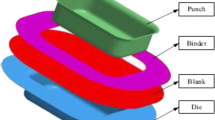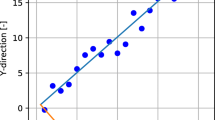Abstract
Deep drawing is an important manufacturing process in industry. In order to obtain high-quality products produced by deep drawing, the set of design variables used in forming operation is designed through deterministic optimization. However, in real forming process, the design variables show variability and randomness which will affect the product quality. These uncertainties are an inherent characteristic of nature and cannot be avoided. This paper focuses on uncertainty analysis of deep drawing with the consideration of uncertainties in material parameters and friction. An uncertainty analysis approach which combines the finite element method (FEM) simulation, surrogate modeling, and Monte Carlo simulation (MCS) is presented in this work. The constructed surrogate models are validated and compared by cross validation and error measures. Then Monte Carlos Simulation is conducted by the use of the constructed surrogate model. The surrogate model based probabilistic method used in this paper is an approach with high-efficiency and sufficient accuracy for uncertainty analysis in deep drawing.
Similar content being viewed by others
References
Han J, Yamazaki K, Makino S, Shirasawa T (2013) Optimization of deep drawing process for circular cup forming, 10th World Congress on Structural and Multidisciplinary Optimization
Sonmez C (2005) Investigation of the deep drawability of steel and aluminum sheets by finite element simulation. Diss. Middle East Technical University
Neto DM, Oliveira MC, Dick RE, Barros PD, Alves JL, Menezes LF (2015) Numerical and experimental analysis of wrinkling during the cup drawing of an AA5042 aluminium alloy. Int J Mater Form:1–14
Barros PD, Simoes VM, Neto DM, Oliveira MC, Alves JL, Menezes LF (2013) On the influence of the yield parameters identification procedure in cylindrical cups earing prediction. In: American institute of physics conference series, vol 1567, pp 512–515
Abdessalem B, El-Hami A (2014) Global sensitivity analysis and multi-objective optimisation of loading path in tube hydroforming process based on metamodelling techniques. Int J Adv Manuf Technol 71(5-8):753–773
Padmanabhan R, Oliveira MC, Alves JL, Menezes LF (2007) Influence of process parameters on the deep drawing of stainless steel. Finite Elem Anal Des 43(14):1062– 1067
Radi B, El Hami A (2007) Reliability analysis of the metal forming process. International Journal of Mathematical and Computer Modelling 45(3-4):431–439
Wiebenga JH (2010) Optimization under uncertainty of metal forming processes-an overview: literature report
Faragher J (2004) Probabilistic methods for the quantification of uncertainty and error in computational fluid dynamic simulations. Defence Science and Technology Organisation Victoria (Australia) Air Vehicles DIV
Hayes KR (2011) Uncertainty and uncertainty analysis methods. Australian Centre of Excellence for Risk Assessment (ACERA) project 0705
Moro T, El Hami A, El Moudni A (2002) Reliability analysis of a mechanical contact between deformable solids. International Journal of Probabilistic Engineering Mechanics 17(N3):227– 232
Messac A (2015) Optimization in practice with MATLAB?: For engineering students and professionals. Cambridge University Press
Forrester A, Sobester A, Keane A (2008) Engineering design via surrogate modelling: a practical guide. Wiley
Ravindran A, Reklaitis GV, Ragsdell KM (2006) Engineering optimization: methods and applications. Wiley
Rasmussen CE (2006) Gaussian processes for machine learning
Martin JD, Simpson TW (2003) A study on the use of kriging models to approximate deterministic computer models. In: ASME 2003 International design engineering technical conferences and computers and information in engineering conference, pp 567–576
Kaymaz I (2005) Application of kriging method to structural reliability problems. Struct Saf 27(2):133–151
Sacks J, Schiller SB, Welch WJ (1989) Designs for computer experiments. Technometrics 31(1):41–47
Ryberg AB, Domeij BR, Nilsson L (2012) Metamodel-based multidisciplinary design optimization for automotive applications
Lin Y (2004) An efficient robust concept exploration method and sequential exploratory experimental design
Ayyub BM, Klir GJ (2006) Uncertainty modeling and analysis in engineering and the sciences. CRC Press
Miller WS, Zhuang L, Bottema J, Wittebrood A, De Smet P, Haszler A, Vieregge A (2000) Recent development in aluminium alloys for the automotive industry. Mater Sci Eng: A 280(1):37–49
Banabic D (2010) Sheet metal forming processes constitutive modelling and numerical simulation. Springer
Neto DM, Oliveira MC, Alves JL, Menezes LF (2014) Influence of the plastic anisotropy modelling in the reverse deep drawing process simulation. Mater Des 60:368– 379
Coer J (2013) Mise en forme par emboutissage en temperature d’un alliage d’aluminium AA5754-O. Diss Universit de Bretagne Sud
Simoes VMN (2012) Analysis of the influence of process parameters in the deep drawing of a cylindrical cup. Phd thesis, Universit de Bretagne-Sud
Radi B, El Hami A (2010) The study of the dynamic contact in ultrasonic motor. Appl Math Model 34 (12):3767–3777
Cherouat A, Radi B, El Hami A (2009) The frictional contact of the shaping of the composite fabric. International Journal Acta Mecanica 199(1-4):29–41
Documentation A (2013) Getting started with Abaqus interactive edition
Chen Z, Dong X (2009) The GTN damage model based on Hill48 anisotropic yield criterion and its application in sheet metal forming. Comput Mater Sci 44(3):1013–1021
Kami A, Dariani BM, Vanini AS, Comsa DS, Banabic D (2015) Numerical determination of the forming limit curves of anisotropic sheet metals using GTN damage model. J Mater Process Technol 216:472–483
Gharib HH (2004) Analysis of the cup drawing process and optimization of the blank holder force. Doctoral dissertation, The American University in Cairo
Abo Al-kheer A, El-Hami A, Kharmanda MG, Mouazen AM (2011) Reliability-based design for soil tillage machines. J Terrramech 48(1):57–64
Mohsine A, El Hami A (2010) A robust study of reliability-based optimisation methods under Eigen-frequency. Int J Comput Methods Appl Mech Eng 199(17-20):1006–1018
Nielsen HB, Lophaven SN, Søndergaard J, Dace A (2002) A Matlab Kriging Toolbox. Technical Report, Technical University of Denmark, Version 2.0 1
Author information
Authors and Affiliations
Corresponding author
Rights and permissions
About this article
Cite this article
Huang, C., Radi, B. & Hami, A.E. Uncertainty analysis of deep drawing using surrogate model based probabilistic method. Int J Adv Manuf Technol 86, 3229–3240 (2016). https://doi.org/10.1007/s00170-016-8436-4
Received:
Accepted:
Published:
Issue Date:
DOI: https://doi.org/10.1007/s00170-016-8436-4




